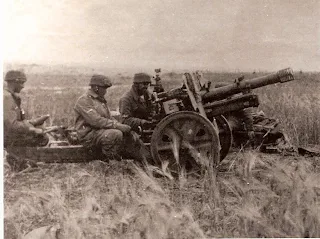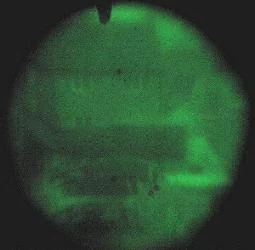I only have a very limited knowledge of WWII German Airborne Forces, my primary area of interest being the British Parachute Regiment and Airborne Forces. I’m not certain of the origin of these photographs but believe them to be personally taken (or had taken) by a Fallschirmjäger Hauptmann (Captain) in an artillery unit assigned to the XI Fliegerkorps (Air Corps). Based on available Order of Battle data it is highly probable that it is Fallschirmjäger Artillery Section 7. The photos depict both the 10.5 cm L.G. (Leichtgeschutz – Light Gun) 40 (105mm Airborne Recoiless Rifle) and 7.5 cm Geb. G 36 ( Gebirgskanon -75mm Mountain Howitzer) in action in Kreta (Crete) during Operation Merkur (Mercury) in 1941. Both recoiless weapons were organic to the TO&E of artillery elements assigned to the Flieger-Division. However, confusion arises due to the same designation, L.G. 40, being given to both a 7.5cm and 10.5cm recoiless rifle. The Flieger-Division was also equipped with the 3.7 cm Pak (37mm Antitank Gun) which was motorcycle towed. The 75mm Mountain howitzers were organic, in 2 Sections (6 guns/section), to the Gebirgs-Artillerie-Regiment 95 (Mountain Artillery) of the 5th Gebirgs Division.
The SdKfz 2 Kettenkraftrad, which was initially designed as a light tractor specifically for the fallschirmjäger, can be seen in the photos as the prime mover for the Geb. G 36 ( Gebirgskanon -75mm Mountain Howitzer). Also seen in one photo are the Sd.Anh. 1 special trailers supplied with the SdKfz 2. Based on the photos it appears that the 750 ccm BMW R75 Kraftrad (motorcycle) was sufficiently powerful to be used as a prime mover for the L.G.40 recoiless rifles.
The SdKfz 2 Kettenkraftrad, which was initially designed as a light tractor specifically for the fallschirmjäger, can be seen in the photos as the prime mover for the Geb. G 36 ( Gebirgskanon -75mm Mountain Howitzer). Also seen in one photo are the Sd.Anh. 1 special trailers supplied with the SdKfz 2. Based on the photos it appears that the 750 ccm BMW R75 Kraftrad (motorcycle) was sufficiently powerful to be used as a prime mover for the L.G.40 recoiless rifles.
Based on the limited view the radio set shown in the one photograph is probably the two-man pack Transceiver (Torn. Fu. a2). The set had a 1 watt power output, giving a range of 9 mi for CW mode and 4 mi for radio/telephone; based on data contained in TM-E 30-451, HANDBOOK ON GERMAN MILITARY FORCES, Department of the Army, 15 March 1945 issue. This particular radio set was standard for communications between infantry regiment (brigade) to battalion, and from battalion to corps.
Both the DFS 320 gliders employed in the invasion of Crete, and the GO 242 subsequently introduced in 1942, primarily as a supply glider on the Eastern Front, can be seen.
It appears that the photographs were taken both during the course of the battle in Crete, as well as the return to depot in Germany.
In several of the photos it can be seen that the captain is wearing the Iron Cross 1st Class, and Luftwaffe Pilot’s badge in addition to his Luftwaffe Parachutist’s badge. In one photo he appears to be talking with Reichmarschall Herman Goring.
A study titled, AIRBORNE OPERATIONS, A German Appraisal, CMH Pub 104-13, U.S. Government Printing Office, 1989, was written for the Historical Division, EUCOM, by a committee of former high ranking German Luftwaffe officers. The list reads like a who's who of the Fallschirmjäger. It follows an outline prepared by the Office of the Chief of Military History, Special Staff, United States Army, and can be read in its entirety at http://www.history.army.mil/books/wwii/104-13/104-13.HTM. In that assessment the following was stated regarding the employment of artillery by the Fallschirmjäger during Operation Murkur. It was written by Oberst (Colonel) Freiherr von der Heydte (awarded Knight's Cross with Oak Leaves of the Iron Cross for action in Crete), an outstanding field commander of German parachute troops.
'The greatest headache for the German paratroop command was the lack of artillery in support of infantry fighting. The German paratroops were equipped with the excellent 75-mm. and 105-mm. airborne recoilless guns; both had short barrels and carriages made of light metal alloy. In suitable terrain the 75-mm. gun could be easily drawn by two men, and its elevation was the same as that of the 37-mm. antitank gun of the Army. The maximum range was 3,850 yards for the 75-mm. gun and 9,000 yards for the 105-mm. gun. Both had the following disadvantages:
a. A large amount of smoke and fumes was generated, and the flash toward the rear was visible at night for a great distance.
b. They could be used only as flat-trajectory weapons. Attempts to use the airborne recoilless guns as high-angle weapons were not satisfactory. Moreover, in an airborne operation it was seldom possible to carry along the necessary amount of ammunition or have it brought up later. Thus, as a rule, only important point targets could be attacked with single rounds, generally from an exposed fighting position.
Besides these weapons, 150-mm. rocket projectiles were used in the Crete operation. They were fired from wooden carrying crates, which also served as aerial delivery containers. These rockets did not prove successful; because of their high degree of dispersion they were suitable only for use against area targets and in salvo fire. However, the quantity of projectiles needed for such a purpose could not be transported on an airborne operation, and a Junkers JU-52 (German troop carrier aircraft) could carry and drop only four projectiles at a time.'
 |
| Oberst Freiherr von der Hydte Commander of 1st Bn 3rd Fallschirmjäger Regt at Crete |































